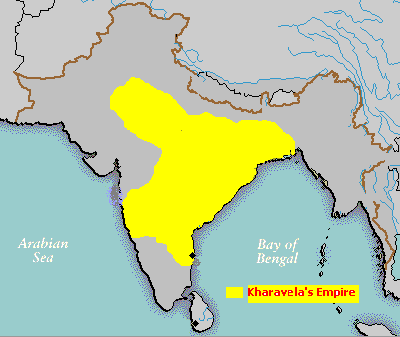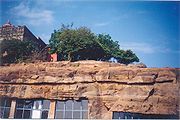
Minor Inscriptions of Kharavela
Encyclopedia


Hathigumpha inscription
The Hathigumpha inscription , from Udayagiri, near Bhubaneshwar in Orissa, was written by Kharavela, the king of Kalinga in India, during the 2nd century BCE...
of Kharavela
Kharavela
Khārabēḷa was the third and greatest emperor of the Mahāmēghabāhana Dynasty of Kaḷinga . The main source of information about Khārabeḷa is his famous seventeen line rock-cut Hātigumphā inscription in a cave in the Udayagiri hills near Bhubaneswar, Orissa.During the reign of Khārabēḷa, the Chedi...
, there are several minor Brahmi
Brāhmī script
Brāhmī is the modern name given to the oldest members of the Brahmic family of scripts. The best-known Brāhmī inscriptions are the rock-cut edicts of Ashoka in north-central India, dated to the 3rd century BCE. These are traditionally considered to be early known examples of Brāhmī writing...
inscriptions in the twin hills of Udayagiri and Khandagiri Caves
Udayagiri and Khandagiri Caves
Udayagiri and Khandagiri Caves are partly natural and partly artificial caves of archaeological, historical and religious importance near the city of Bhubaneswar in Orissa, India. The caves are situated on two hills Udayagiri and Khandagiri, mentioned as Kumari Parvat in Hathigumpha inscription...
, which were deciphered earlier by Prof. R. D Banerjee during the years 1915–16 (Epigraphic Indica – XIII) and B. M Barua (Indian Historical Quarterly-XIV). These minor inscriptions throw light on the reign and kingdom of Kharavela
Kharavela
Khārabēḷa was the third and greatest emperor of the Mahāmēghabāhana Dynasty of Kaḷinga . The main source of information about Khārabeḷa is his famous seventeen line rock-cut Hātigumphā inscription in a cave in the Udayagiri hills near Bhubaneswar, Orissa.During the reign of Khārabēḷa, the Chedi...
. Shri Sadananda Agrawal, historian, has given further clarifications about them, which are produced as under:
I- Mancapuri cave inscription (Upper storey)
This inscription is engraved on the raised space between the second and third doorways of the cave at Mancapuri. The text in DevanagariDevanagari
Devanagari |deva]]" and "nāgarī" ), also called Nagari , is an abugida alphabet of India and Nepal...
script is as under:
L.1- अरहंत पसादाय कलिंगानं समनानं लेनं कारितं राजिनो ललाकस
L.2- हथिसिहस पपोतस धुतुना कलिंग चकवतिनो सिरिखारवेलस
L.3- अगमहिसिना कारितं
Translation: By the blessings of Arihants ( Tirthankar
Tirthankar
In Jainism, a ' |ford]]-Maker", ) is a human being who achieves moksa through asceticism and who then becomes a role-model and teacher for those seeking spiritual guidance....
, the chief queen of Kharavela, the Chakravarti monarch of Kalinga, the great granddaughter of Hathisiha (Hasti Simha) and the daughter of Lalāka or Lalārka, caused to be constructed the caves for the sramanas of Kalinga.
II- Mancapuri cave inscription (Upper storey)-A
This inscription is incised on a raised bend between the 3rd and 4th doorways from the left and contains single line. The text in DevanagariDevanagari
Devanagari |deva]]" and "nāgarī" ), also called Nagari , is an abugida alphabet of India and Nepal...
script is as under:
ऐरस महाराजस कलिंगाधिपतिना महामेघवाहनस कुदेपसिरिनो लेणं
Translation: This is the cave of Aira
Aira
Aira is a genus of about 10 species of annual grasses, native to western and southern Europe, southwest Asia and Africa. The common name, shared with the similar related genera Deschampsia and Koeleria, is Hair-grass, from the very slender leaves and stems...
Mahameghavahana Maharaja Kudepasiri
Kudepasiri
Kudepasiri was a King of Kalinga and successor of Kharavela. The information about King Kudepasiri is available from a minor inscription cave no 9- Mancapurigumpha on Udayagiri hills situated near Bhubaneswar in Orissa....
, the overlord of Kalinga
Kalinga
Kalinga is a landlocked province of the Philippines in the Cordillera Administrative Region in Luzon. Its capital is Tabuk and borders Mountain Province to the south, Abra to the west, Isabela to the east, Cagayan to the northeast, and Apayao to the north...
, where, Kudepasiri
Kudepasiri
Kudepasiri was a King of Kalinga and successor of Kharavela. The information about King Kudepasiri is available from a minor inscription cave no 9- Mancapurigumpha on Udayagiri hills situated near Bhubaneswar in Orissa....
is considered to be the immediate successor of Kharavela
Kharavela
Khārabēḷa was the third and greatest emperor of the Mahāmēghabāhana Dynasty of Kaḷinga . The main source of information about Khārabeḷa is his famous seventeen line rock-cut Hātigumphā inscription in a cave in the Udayagiri hills near Bhubaneswar, Orissa.During the reign of Khārabēḷa, the Chedi...
.
III-Manchapuri cave inscription 'B' (Lower storey)
This inscription has been engraved on the right wall of veranda, to the right of the entrance to the right-hand side chamber of the main wing, consisting of one line.The text in Devanagari
Devanagari
Devanagari |deva]]" and "nāgarī" ), also called Nagari , is an abugida alphabet of India and Nepal...
script is as under:
कुमारो वडुखस लेणं (IAST
IAST
The International Alphabet of Sanskrit Transliteration is a transliteration scheme that allows a lossless romanization of Indic scripts as employed by the Sanskrit language.-Popularity:...
: kumāro vadukhas lenam)
Translation: (This is) the cave of Prince .
Note: On paleographic grounds, Prof. R. D. Banerjee considered this inscription to pre-date the inscription of King Kudepasiri. According to Sadananda Agrawal, Prince Badukha stands an obscure figure in history, but Badukha seems to be the son or brother of Kudepasiri.
IV- Inscriptions in the Sarpagumpha
This inscription consisting of one line, is incised over the doorway of the Sarpagumpha. The text in DevanagariDevanagari
Devanagari |deva]]" and "nāgarī" ), also called Nagari , is an abugida alphabet of India and Nepal...
script is as under:
चूलकमस कोठाजेया च (IAST
IAST
The International Alphabet of Sanskrit Transliteration is a transliteration scheme that allows a lossless romanization of Indic scripts as employed by the Sanskrit language.-Popularity:...
: cūlakamas koţhājeyā ca)
Translation: The chamber and veranda/or side chamber of cūlakama. However, Dr. Sahu has interpreted Ajeya being united by a Sandhi qualifying Koṭha there by denoting invincible.
V- Inscription in the Sarpagumpha
The text of the engravings at the left of the doorway in DevanagariDevanagari
Devanagari |deva]]" and "nāgarī" ), also called Nagari , is an abugida alphabet of India and Nepal...
script is as under:
L.1- कंमस हलखि
L.2- णय च पसादो
Translation: [The pavilion is the] gift of Kamma and Halakhina.
It has been claimed that Halakhina was the wife of Kamma. Chūlakamma – found in the inscription No. IV and Kamma of this record indicate official designations rather than the proper names. Kamma may be taken as minister of works (Karma sachiva) and Cūlakamma appears to be a junior cadre of minister in the Department of works.
VI- Haridas Cave inscription
This inscription contains one line has been incised over one of the three entrances to the main chamber of the cave from the veranda. The text in DevanagariDevanagari
Devanagari |deva]]" and "nāgarī" ), also called Nagari , is an abugida alphabet of India and Nepal...
script is as under:
चूलकमस पसातो कोठाजेया च (IAST
IAST
The International Alphabet of Sanskrit Transliteration is a transliteration scheme that allows a lossless romanization of Indic scripts as employed by the Sanskrit language.-Popularity:...
: cūlakamas pasāto koţhājeyā ca)
Translation: The chamber and veranda (or side chamber) are the gift of cūlakama.
VII- Vyāghragumphā Inscription
The record is incised on the outer wall of the inner chamber. The text in DevanagariDevanagari
Devanagari |deva]]" and "nāgarī" ), also called Nagari , is an abugida alphabet of India and Nepal...
script is as under:
L.1- नगर अखंदस
L.2- स भूतिनो लेणं
Translation: This is the cave of Bhūti, the city judge.
VIII- Jambesavara cave inscription
This inscription has been engraved over the entrances to the inner chamber of the cave. The text in DevanagariDevanagari
Devanagari |deva]]" and "nāgarī" ), also called Nagari , is an abugida alphabet of India and Nepal...
script is as under:
महादस बरयाय नकियस लेनं
Translation: The cave of Mahamāda Nākiya and Bāriyā.
X- Tatowāgumphā inscription (Cave No −1)
The record of this inscription is incised over one of the entrances to the inner chamber. The text in Sanskrit reads as:पादमुलिकस कुसुमस लेणं x [।।] (IAST
IAST
The International Alphabet of Sanskrit Transliteration is a transliteration scheme that allows a lossless romanization of Indic scripts as employed by the Sanskrit language.-Popularity:...
: pādamulikas kusumas lenam x)
Translation: The cave of Kusuma
Kaswan
Kaswan or Kuswan or Kasuan is a gotra of jats in Rajasthan and Haryana in India. The word Kaswan is 'XWN' of Tocharian language meaning 'King'.-Origin of Kaswan :...
, the padamulika.
There is a syllable after the word lenam, which may be read as ni or phi,. padamulika literally means, one who serves at the feet [of king]. According to Kishori Lal Faujdar (Page No. 6, Supra), Kusuma seems to be related with Kaswan
Kaswan
Kaswan or Kuswan or Kasuan is a gotra of jats in Rajasthan and Haryana in India. The word Kaswan is 'XWN' of Tocharian language meaning 'King'.-Origin of Kaswan :...
clan of Jats. He refers to an article named ‘Hathi Gumpha
Hathigumpha inscription
The Hathigumpha inscription , from Udayagiri, near Bhubaneshwar in Orissa, was written by Kharavela, the king of Kalinga in India, during the 2nd century BCE...
and Three other Inscriptions’ (page 24) in Devanagari
Devanagari
Devanagari |deva]]" and "nāgarī" ), also called Nagari , is an abugida alphabet of India and Nepal...
as under:
कुसवानाम् क्षत्रियानां च सहाय्यतावतां प्राप्त मसिक नगरम्
.
Translation: The city of 'Masikanagara' was attained with the help of 'Kuswan
Kaswan
Kaswan or Kuswan or Kasuan is a gotra of jats in Rajasthan and Haryana in India. The word Kaswan is 'XWN' of Tocharian language meaning 'King'.-Origin of Kaswan :...
' Kshatriya
Kshatriya
*For the Bollywood film of the same name see Kshatriya Kshatriya or Kashtriya, meaning warrior, is one of the four varnas in Hinduism...
s.
Sadananda Agrawal has interpreted Masikanagara as Asikanagara and identified it with the city Adam (Present Nagpur District of Maharashtra). In view of the evidence of a highly prosperous city unearthed at Adam, Prof. A. M. Shastri is of the opinion that Adam itself represents the Asikanagara of Hathigumpha inscription
Hathigumpha inscription
The Hathigumpha inscription , from Udayagiri, near Bhubaneshwar in Orissa, was written by Kharavela, the king of Kalinga in India, during the 2nd century BCE...
. It is worth noting in the present context that terracotta seal having a legend has been discovered from Adam situated on the right bank of the river Wainganga, which reads Asakajanapadasa
Assaka
Assaka , was one of ancient Indian regions . It is one of the solasa mahajanapadas in the 6th century BCE, mentioned in the Buddhist text Anguttara Nikaya....
(Devanagari: असकजनपदस).
XI- Ananta Gumpha inscription (A)
The record is incised on the architrave between the left ante and the fifth pillar. The text in DevanagariDevanagari
Devanagari |deva]]" and "nāgarī" ), also called Nagari , is an abugida alphabet of India and Nepal...
script is as under:
दोहद समणनं लेणं
Translation: The cave of the Dohada .

